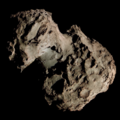82P/Gehrels
Nowadays, 82P/Gehrels has become a topic of great relevance in our society. With the advancement of technology and globalization, 82P/Gehrels has become increasingly important in our lives. Whether on a personal, professional or social level, 82P/Gehrels has become a determining factor in our decisions and in the way we interact with the world around us. In this article we will explore the impact of 82P/Gehrels on different aspects of our lives, as well as the implications it has for the future.
| Discovery[1] | |
|---|---|
| Discovered by | Tom Gehrels |
| Discovery site | Palomar Observatory |
| Discovery date | 27 October 1975 |
| Designations | |
| P/1975 U1 P/1984 P1 | |
| |
| Orbital characteristics[5][6] | |
| Epoch | 25 February 2023 (JD 2460000.5) |
| Observation arc | 44.56 years |
| Number of observations | 149 |
| Aphelion | 4.638 AU |
| Perihelion | 3.629 AU |
| Semi-major axis | 4.133 AU |
| Eccentricity | 0.12207 |
| Orbital period | 8.403 years |
| Inclination | 1.1259° |
| 239.25° | |
| Argument of periapsis | 226.43° |
| Mean anomaly | 200.37° |
| Last perihelion | 28 June 2018[2][3] |
| Next perihelion | 14 November 2026[4] |
| TJupiter | 3.027 |
| Earth MOID | 2.643 AU |
| Jupiter MOID | 0.517 AU |
| Physical characteristics[7] | |
| Dimensions | 1.46 km (0.91 mi) |
| Comet total magnitude (M1) | 7.6 |
| Comet nuclear magnitude (M2) | 16.4 |
82P/Gehrels is a periodic comet that was discovered on 27 October 1975, by Tom Gehrels at the Palomar Mountain Observatory in California having a faint nuclear brightness of magnitude 17.[5]
Calculations based on the early sightings gave an estimated perihelion of 23 April 1975 and an orbital period of 8.11 years. It was observed by J. Gibson on its next predicted apparition in 1984, using the 122-cm Schmidt at Palomar, when he estimated the nuclear brightness at a very faint magnitude 20. It has since been observed in 1993, 2001 and 2010.[8]
The object has been identified as a quasi-Hilda comet, which means it is near a 3:2 mean-motion resonance with the planet Jupiter.[9] It fits the definition of an Encke-type comet with (TJupiter > 3; a < aJupiter).[5] It has an estimated diameter of 1.46 km (0.91 mi).[7]
On 15 August 1970 the comet passed 0.00143 AU (214,000 km; 133,000 mi) from Jupiter.[5]
See also
- Comet Gehrels
- List of numbered comets
References
- ^ T. Gehrels (1975). B. G. Marsden (ed.). "Possible Comet Gehrels". IAU Circular. 2861: 1. Bibcode:1975IAUC.2861....1S.
- ^ S. Yoshida (3 July 2011). "82P/Gehrels 3". www.aerith.net. Retrieved 18 February 2012.
- ^ P. Rocher (23 March 2011). "Note number: 0090 P/Gehrels 3 : 82P". IMCCE. Retrieved 19 February 2012.
- ^ "Horizons Batch for 82P/Gehrels 3 (90000860) on 2026-Nov-14" (Perihelion occurs when rdot flips from negative to positive). JPL Horizons. Retrieved 27 June 2022. (JPL#19 Soln.date: 2021-Mar-19)
- ^ a b c d "82P/Gehrels 3 – JPL Small-Body Database Lookup". ssd.jpl.nasa.gov. Jet Propulsion Laboratory. Retrieved 18 February 2012.
- ^ "82P/Gehrels Orbit". Minor Planet Center. Retrieved 29 March 2025.
- ^ a b P. L. Lamy; I. Toth; Y. R. Fernandez; H. A. Weaver (2004). "The sizes, shapes, albedos, and colors of cometary nuclei". In M. C. Festou; H. U. Keller; H. A. Weaver (eds.). Comets II. Bibcode:2004come.book..223L.
- ^ G. W. Kronk. "82P/Gehrels 3". Cometography.com. Retrieved 24 February 2015.
- ^ K. Ohtsuka; T. Ito; M. Yoshikawa; D. J. Asher; H. Arakida (2008). "Quasi-Hilda comet 147P/Kushida-Muramatsu. Another long temporary satellite capture by Jupiter". Astronomy and Astrophysics. 489 (3): 1355–1362. arXiv:0808.2277. Bibcode:2008A&A...489.1355O. doi:10.1051/0004-6361:200810321. S2CID 14201751.
External links

